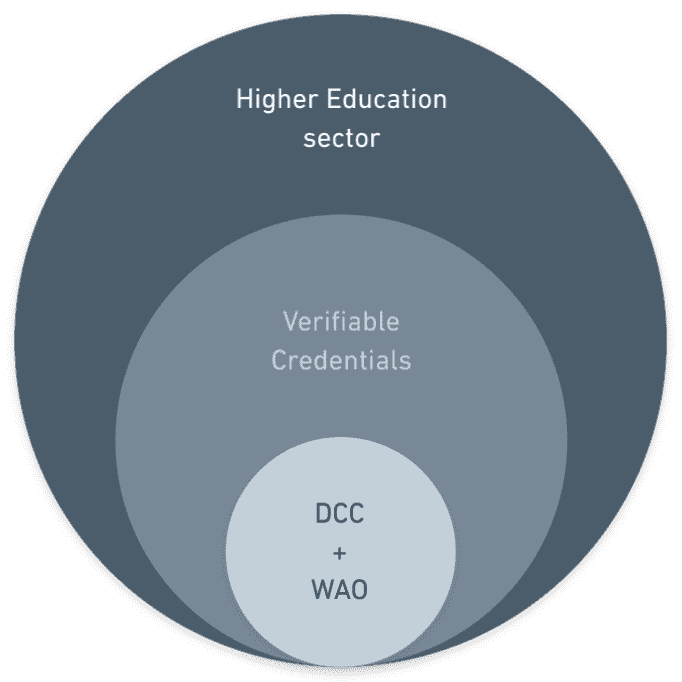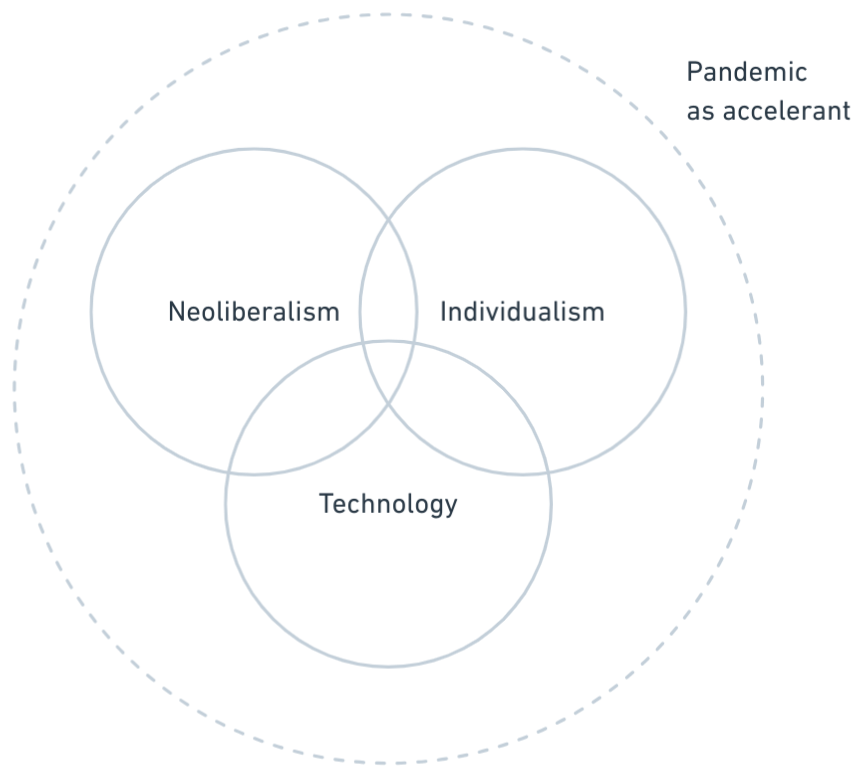TB872: Outlining the type of change I hope to see in my situation of concern
Note: this is a post reflecting on one of the modules of my MSc in Systems Thinking in Practice. You can see all of the related posts in this category.
In my previous post about the meta-narrative for my systemic inquiry, I offered some insights into the dominant beliefs, values, and assumptions, that drive actions and interactions within the system. In this case, it’s the equivalent of Russian dolls nested inside one another: the Digital Credentials Consortium (DCC)’s technology, inside the Verifiable Credentials (VC) standard, inside digital credentials, inside alternative credentialing, inside assessment practices, inside US Higher Education (HE), inside global post-compulsory education.
For the purposes of this post, which focuses on the type of change I hope for in my system of concern, I’ll simplify this a bit:

The first circle represents the collaboration between DCC and WAO, the second both the Verifiable Credentials Credentials standard and existing practices around it, with the third the Higher Education sector. By the latter I primarily mean the current situation of HE institutions in the USA, Canada, and Mexico, as these have been those most willing to experiment with the DCC’s technologies up to this point.
In my previous post, I included this Venn diagram which I used to situate the work that we are doing within a (much) larger picture:

As I pointed out:
It is into this neoliberal, individualised, technology-infused world that the DCC operates in its promotion of VCs. There are registrars of institutions who are motivated to move slowly, and preserve the reputation of their institution. There are vendors and IT departments who would like to adopt VCs for commercial or technological reasons. And there are funders with different agendas, who seek to either mitigate problems, or accelerate them to achieve a future state.
A chaotic system of digital credentials does not benefit the current major stakeholders in the HE landscape. Their main product, degrees, have an established authority and ‘currency’ in the market. However, they are aware that students (financial considerations), employers (changes in working practices), and competitors (increasing opportunities) are itching for change.
So, in terms of the type of change I hope for in my situation of concern, I think we’re aiming for the following:
- Greater understanding within the HE sector of what VCs are and how they can be used. This will be evidenced by more nuanced language being used in the ‘microcredentials’ discourse and senior leaders within HE institutions using the language of VCs, wallets, and potentially the DCC’s technology. We should see
- Increased use of VCs by HE institutions in the Americas (and beyond). As this is a decentralised system, this will be evidenced by press releases and other information provided by institutions themselves. Potentially, this could include mailing lists and presentations at events.
- Fewer basic questions from DCC partner institutions around technical implementation. We know that partner institutions sometimes get stuck and need guidance from the DCC core team. This potentially reduces the confidence of partner institutions, and is a time sink for the DCC team. By improving technical documentation to include Frequently Asked Questions (FAQs) as well as being more up-to-date, this should reduce the number of similar queries around deployment.
- Increased use of the DCC’s reference implementations. Again, this is a decentralised system, but we would expect that HE institutions would be in regular contact with the DCC core team. This may be to seek advice and guidance on their specific implementation, or for feature requests.
- Open Source contributions by DCC partner institutions. As a consortium, the DCC has partner institutions who we would expect to be more active than others who might be interested in the technology. We would envisage this to be reflected in the DCC GitHub repositories in terms of everything from pull requests to ‘stars’.
I have chosen not to include what HE institutions use VCs for as I think this would betray my biases too much. As I have said in previous posts, I am advocating for a world of Open Recognition, whereas the first step for our work with the DCC is to encourage HE institutions to issue course completion certificates using VCs.

I have also chosen not to include change relating to employers’ or learners’ acceptance and understanding of VCs. That is to say, I have been intentional about the boundary here, as otherwise it would be far too large to influence. Changing hiring practices and behaviours is a very slow process, and as I know from my work on Open Badges, you need enough ‘supply’ to provide an argument for change.
Note that all of these reflections are based on my own personal understanding and represent thinking-in-progress. They don’t represent the opinions of other WAO members and collaborators, and certainly don’t represent any settled position of the DCC. I’m just working in the open, as usual.

